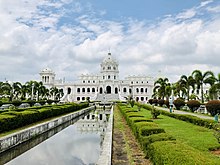History

Agartala is the capital of one of the Indian state namely Tripura and is second largest city in North-east India after Guwahati. Agartala is a component of two words namely ‘Agar’ a kind of oily valuable perfume tree and suffix ‘tala’ a store house. ‘Agar’ i.e. ‘Agaru’ tree was plenty in this region. Agartala lies on the bank of Haora River and is located 2 km from Bangladesh. Agartala has a monsoon influenced humid subtropical climate with large amounts of rain almost all year. The city experiences long, hot and wet summers, lasting from April to October. Average temperatures are around 28 °C (82 °F), fluctuating with rainfall. There is a short, mild winter from mid-November to early March, with mostly dry conditions and average temperatures around 18 °C (64 °F). The best time to visit is from September to February. Summers are quite long and is hot and humid. The river Haora flows through the city and remains flooded with water during the time of monsoon. The present territory of Tripura predominantly hilly with a geographical area of 10,491 Sq. Km and is surrounded on three sides by deltaic basin of Bangladesh with tropic of cancer passing through it. Tripura lies in a geographically disadvantageous location in India, as only one major highway, the National Highway 44, connects it with the rest of the country. Five mountain ranges Boromura, Atharamura, Longtharai, Jampui Hills, the capital, is located on a plain to the west. The state has a tropical savanna climate and receives seasonal heavy rains. Forests cover more than half of the area, in which many species found in any Indian state. Due to its geographical isolation, economic progress in the state is hindered. Poverty and unemployment continue to plague Tripura, which has a limited infrastructure. Most residents are involved in agriculture and allied activities, although the service sector is the largest contributor to the state’s gross domestic product.



